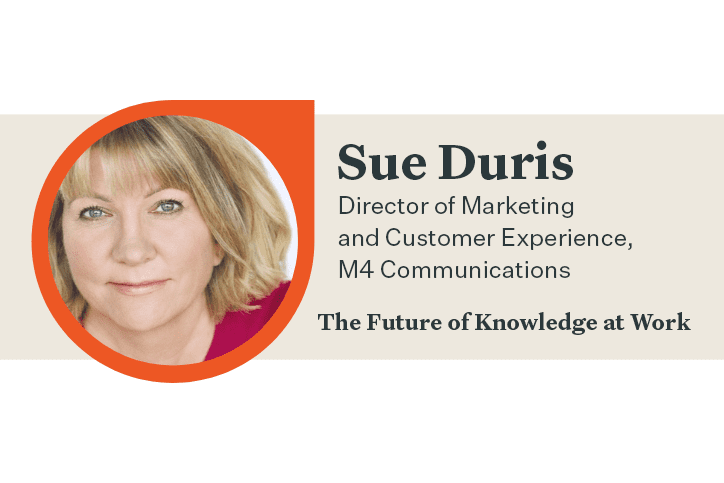Bloomfire Q&A: Sue Duris on Creating an Org-Wide CX Vision, Essential Leadership Skills, and More

Customer experience (CX) is rapidly becoming the key success factor for businesses. In fact, a recent survey found that business leaders rank customer experience as their top priority of the next five years.
But while senior leaders recognize the value of CX, many organizations still struggle to align departments around a shared CX vision and deliver consistent customer experiences. We recently spoke to Sue Duris, Director of Marketing and Customer Experience at M4 Communications, about this challenge, as well as other challenges and opportunities for organizations to increase their CX maturity.
Sue has more than 15 years of experience in CX and marketing, with a focus on aligning culture, employee experience, and customer experience to drive customer lifetime value, profitability, and growth. She spends much of her time working with early and later stage B2B tech startups to help them define product/market fit and build their customer development strategy. She also regularly speaks and writes on CX and marketing topics and hosts #CXChat, a weekly Twitter chat for customer experience professionals.
Check out our Future of Knowledge at Work interview with Sue below.
Tell us a little about yourself.
I have lived in Surrey, England for the past three years now. I fell in love with the UK five years ago and knew I wanted to be here. Luckily I was quickly able to get a work visa and found clients who understand the importance of customer centricity and Customer Experience. Prior to that, I was splitting my time between Silicon Valley and Los Angeles. I’m a former actor—and still a Screen Actors Guild member. I love my 70’s rock n’ roll: I’m a HUGE Queen fan, plus I love Jimi Hendrix, Led Zeppelin, the Rolling Stones, T Rex, the Eagles, and others. I love skiing, hiking, meditation, film, theatre, music, and traveling. And I love dogs! I have a American Staffordshire terrier named Scoobie.
How did you start your career in marketing and customer experience?
I actually started in finance. I received my BA in Economics and enjoyed my econometrics courses so much that I wanted to get involved in corporate financial planning and analysis. From there, I became an accidental marketer. There wasn’t any “I want to go into marketing” plan. I was managing billing for a telecom carrier that would become MCI WorldCom, and the VP of Sales and Marketing recruited me to be a senior product manager managing all the long-distance voice products.
From there, I ran product marketing, then marketing for startups, and worked in VP/CMO roles, which was around the time I ventured into customer experience (CX). In reality, I had been practicing many of the elements of CX since the 90s, such as developing and marketing products in an outside-in manner—focused on what the customer wanted—versus inside-out—an “if we build it, they will come” mentality. The latter is a recipe for disaster. This is why I am a big advocate of product-market fit—if we focus on unmet or under-met needs, then we can align teams to customer needs, make the CX vision a reality, and grow in the process.
What are some of the skills and areas of knowledge that you think are essential to succeed as both a marketing and CX leader?
Collaboration across teams is a must. So is understanding data from the point of knowing the KPIs that are going to get a business closer to its north star. It’s also valuable to have soft skills such as empathy, curiosity, coaching, etc. The ability to be a strategist and tactician, and knowing the forest from the trees, is important, as is the ability to communicate clearly, concisely, and consistently while telling a story that resonates for the audience.
The big thing I find with both marketing and CX in companies is you are a consultant—you are providing an objective view on the issue and solutions. CX professionals, whether they are practitioners within a company or consultants, shoot themselves in the foot when they think there is one solution and one solution only to build CX and drive CX maturity. That is the wrong approach. Working collaboratively to find the right solution for the customer base and the company is key.
More and more businesses are seeking to make customer experience central to their organization (rather than making it the responsibility of any one department). What are some of the biggest knowledge management challenges you see businesses facing as they seek to centralize CX?
I believe CX should be set up like a project management office (PMO). It is its own organization with representation from every department. This is the only way teams can be aligned and row in the same direction to implement the CX vision across the organization. If CX is housed in, say, Marketing, Marketing doesn’t always have responsibility for the entire customer journey, so in a sense, CX is out of the loop and the experience for customers is inconsistent. When that happens, they will leave to go to a competitor. Also, having CX housed in one department can silo it. Silos are bad. This is why centralizing CX is really the only way to go.
What best practices would you recommend for businesses that want to align every team and department around CX?
I suggest centralizing CX by creating a PMO-type organization. Prior to that, I recommend CX be top-down and bottom-up. It should be top-down in the sense that the C-suite must champion CX and bottom-up through ensuring employee experience is strong and employees know about CX, why it is important, and what role they individually play in it. When they know this, they will buy into CX and take ownership for it. A top-down, bottom-up, across-the-organization alignment will ensure CX is strong and will drive growth.
Thoughts on how new technologies will impact the ways different teams share and engage with knowledge around the customer?
Tech has really upped its game so much that CX pros can take deeper dives into customer insights, personalization, and predictive analytics to be steps ahead of customers, which is mandatory to manage constantly changing expectations, predict behaviors, and be proactive.
One area where a lot of strides are being made is in conversational AI. Sophisticated chatbots can now converse like a live agent and hand off to a live agent when and where necessary. Other emerging tech—AR, VR, and mixed reality—offer enriching and immersing experiences, and the Internet of Things is providing additional insight into customer preferences and behaviors.
What’s one area of knowledge or professional development that you’re looking forward to expanding upon or pursuing this year?
I am a growth mindset girl, and I’m always growing. I’m very interested in the human condition, so empathy and curiosity are key for me. I want to understand what makes people tick, why they make the choices they do. Understanding people so that we can help guide them is a big part of CX, and if we don’t take interest in finding out about them so we can help them, then we shouldn’t be in CX.
Additionally, spending more time with clients is important—we should be calling at least one customer a day and asking two questions: (1) how are you doing today? and (2) what is the one thing I/we can be doing to help you be more successful? It takes 10-15 minutes, yet so many don’t reach out and call customers.
Thank you for sharing your insights with us, Sue!
Interested in seeing more Future of Knowledge at Work interviews with customer experience leaders? Check out these entries:
Jeannie Walters, CEO of Experience Investigators, on the Evolution of CX
Lynn Hunsaker on Closing the Brand-Customer Gap
Ricardo Saltz Gulko on Delivering Meaningful, Simplified Human Experiences

How to Build an Insights Engine: The People, Technology, and Culture You Need

How to Measure the ROI of Knowledge Management

How to Navigate the Chain of Command in Business to Get Executive Buy-in

Start working smarter with Bloomfire
See how Bloomfire helps companies find information, create insights, and maximize value of their most important knowledge.

Take a self guided Tour
See Bloomfire in action across several potential configurations. Imagine the potential of your team when they stop searching and start finding critical knowledge.